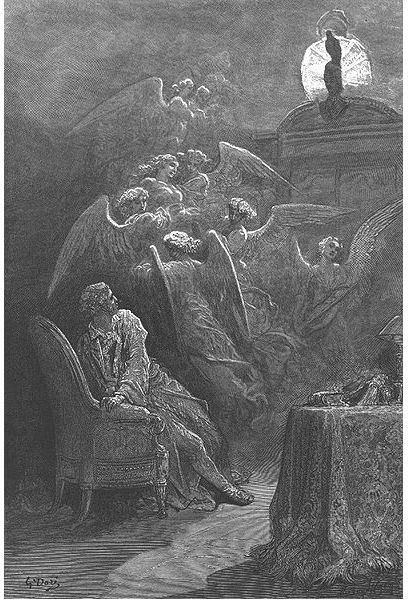An Analysis of Famous Quotes from Edgar Allan Poe's Short Stories & Poems
Edgar Allan Poe Quotes with Analysis
Quote: And Darkness and Decay and the Red Death held illuminable dominion over all.
Analysis: This cheerful axiom comes from “The Masque of the Red Death” and refers to the death of Prince Prospero and his thousand knights and dames. Poe himself was no stranger to darkness, decay, and death, having many of those close to him, including his beloved wife, die of tuberculosis, characterized by the coughing up of blood.
Quote: It was many and many a year ago, / In a kingdom by the sea, / That a maiden there lived whom you may know / By the name of Annabel Lee (1-4)
Analysis: And so begins “Annabel Lee,” Poe’s tribute to his dead wife. Poe honors her in this poem of idealized love. It tells of the death of a young woman. Annabel Lee is a more fitting name for the poem than Virginia Clemm, it not being an easy name to rhyme with (phlegm, hem, them, gem not really doing it for me).
**
Quote: Once upon a midnight dreary, while I pondered weak and weary (1).
Analysis: And so begins Poe’s most famous poem, “The Raven.” Poe establishes the unreliability of his narrator in line 1, stating that it’s late at night, he’s reading, and he’s tired. It’s quite possible the narrator is dreaming the entire episode with the raven (For an in depth summary and analysis of “The Raven,” follow the link.
Quote: I was never kinder to the old man than during the whole week before I killed him.
Analysis: Speaking of unreliable narrators, this one from the “Tell-Tale Heart” presents a similar problem as the one in “The Raven” (and many Poe short stories): How do we know what the narrator says is true. In this example, the narrator tells us he is not mad, yet proceeds to narrate events that demonstrate otherwise. He brags about how he planned the murder, mentioning how kind he had been and how skillful he hid the dead body, blaming his capture on the supernatural beating of the old man’s heart. How do we know he didn’t botch the entire thing and then blame it on the freakish heart to make himself look less incompetent? Maybe I’m reading too much into this?

Quote: I aimed a blow at the animal. But this blow was arrested by the hand of my wife. Goaded by the interference into a rage more demoniacal, I withdrew my arm from her grasp and buried the axe in her brain.
Analysis: Something about this line in “The Black Cat” makes me giddy. It’s so well written and sudden and shocking and delightful. I hate that cat. It torments our drunk, insane, abusive narrator and deserved to die. If it weren’t for that meddling wife of his, he would of rid himself and the world of that demoniacal cat forever. But no, she had to prevent him from murdering the fiendish feline.
Of course, it is possible that the narrator is just plain nuts and that the image of a hanged cat had not really appeared on the wall of his burned down house; perhaps an identical cat did not appear to him during a drunken stupor and follow him home; and perhaps a portion of the cat’s fur did not turn white in the shape of the gallows. In fact, it’s possible none of this happened and the narrator was just a psychopathic killer. Maybe I’m reading too much into this?
Quotes from Poe’s Short Stories
Quote: Coincidences, in general, are great stumbling blocks in the way of that class of thinkers who have been educated to know nothing of the theory of probabilities- that theory to which the most glorious objects of human research are indebted for the most glorious of illustration (The Murders in the Rue Morgue).
Analysis: There’s more to Poe than writing about demoniacal cats, supernatural hearts and talking birds. He is credited with writing the first mystery, “The Murders in the Rue Morgue,” and by so doing, establishing the detective genre. In his mysteries, the detective solves crimes using logic and reason and removing emotion out of the decision process.
Quote: During the whole of a dull, dark, and soundless day in the autumn of the year, when the clouds hung oppressively low in the heavens, I had been passing alone, on horseback, through a singularly dreary tract of country, and at length found myself, as the shades of the evening drew on, within view of the melancholy House of Usher.
Analysis: It doesn’t take a literary genius to figure something bad’s going to happen in this story. Poe demonstrates his brilliance in establishing a story’s mood in the opening. Here he does so with word choice–singularly dreary, dull, dark, clouds hung oppressively low–and alliteration and assonance.
Quotes from Poe’s Poems

Quote: Gaily bedight, / A gallant knight, / In sunshine and in shadow, / Had journeyed long, / Singing a song, / In search of Eldorado. (1-6).
Analysis: Here we have the first stanza to the poem “Eldorado.” In the first stanza the knight (pardon this incredibly trite expression) finds joy in the journey (bedight means to decorate or dress). The word bedight is a Middle English word, which makes sense since knights lived in the Middle Ages. This, my friends, is one helluva gaily decorated, armored man (for an in depth analysis of “Eldorado,” follow the link).
Quote: Open here I flung the shutter, when, with many a flirt and flutter, / In there stepped a stately raven, of the saintly days of yore.
Analysis: And in here steps the most famous character in the most famous poem written by an American author. The arrival of a talking bird satisfies the American Romantic fascination with death and the supernatural, as the bird torments the narrator about his lost love, Lenore. Once again we see the theme of losing one’s love in an Edgar Allan Poe literary work.
Quote: From the bells, bells, bells, bells, / Bells, bells, bells,– / From the jingling and the tinkling of the bells.
Analysis: This sample from “The Bells” demonstrates how Poe masterfully uses sound devices to create an impression. “The Bells” contain alliteration, assonance, consonance, onomatopoeia, repetition, internal rhyme, and any other sound device you can think of (For a more in depth look at “The Bells,” follow the link).
This post is part of the series: Masque of the Red Death Study Guide
Avoid becoming a bloody mess on your next short story test. Use this study guide and keep the “Red F” away!
- Summary of “The Masque of the Red Death” by Edgar Allan Poe
- Symbolism in “The Masque of the Red Death”
- “The Masque of the Red Death” Literary Analysis: A Look at Imagery
- Setting, Characters, Theme and Irony in “The Masque of the Red Death”
- An Analysis of Edgar Allan Poe Quotes
